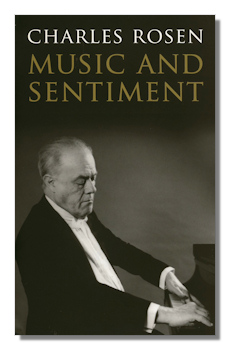
The Internet's Premier Classical Music Source
Related Links
-
Introduction
Acoustics
Ballet
Biographies
Chamber Music
Composers & Composition
Conducting
Criticism & Commentary
Discographies & CD Guides
Fiction
History
Humor
Illustrations & Photos
Instrumental
Lieder
Music Appreciation
Music Education
Music Industry
Music and the Mind
Opera
Orchestration
Reference Works
Scores
Thematic Indices
Theory & Analysis
Vocal Technique
Search Amazon
Recommended Links
Site News
 Book Review
Book Review
Music and Sentiment

Charles Rosen
Yale University Press, 2010. 146 pages.
Numerous musical illustrations.
ISBN-10: 0300126409
ISBN-13: 978-0300126402
At under 140 pages this is a short book. But it's very reasonably priced – even in hardback. More to the point, it has a simple and manageable thesis which one of the greatest musicians of our time explores succinctly and trenchantly. Rosen asks, "How does music convey the emotions it does?" "Sentiment", then, is to be taken as emotion, feeling; not as "sentimentality". Such a question seems so important that it's hard to imagine it's not been at least asked, if not answered, before.
And of course it has. Writers as far apart in time as Johann Mattheson, who attempted to assign emotions to keys; Deryck Cooke, in "The Language of Music" (Clarendon Paperbacks, ISBN-10: 0198161808, ISBN-13: 978-0198161806); and Leonard B. Meyer (Emotion and Meaning in Music, Phoenix Books ISBN-10: 0226521397 ISBN-13: 978-0226521398), as well as Daniel J. Levitin have developed more or less successful aesthetics. It would be better to say, "safer" or "contentious" aesthetics for no such theory has found universal acceptance.
Rosen has taken a different path in this excellent and, this time, convincing book from Yale University Press published in June 2010. Rosen is not in the business of "decoding" music to discover constants or musical conduits from which flow inevitable psychological effects. Rather, he looks closely and analytically at examples from the Baroque to Berg. He examines how the totality of their musicality contributes to the responses we have, how their stylistic expertise has been used to convey sentiment generally. Rosen is not averse to examinations of key… he devotes a very interesting chapter to what he calls the "C minor style".
Indeed, his concentration is as much on the ways in which composers' desire to express feeling has been central to their very compositional process. Feeling, Rosen, suggests, is also central to any kind of techniques which composers use to achieve their results. Seen from the listener's perspective, which is, after all, for whose benefit the composer intends their music, "… grasping its emotional or dramatic meaning is either immediate or requires only becoming familiar with it" [page ix]. This is not a statement with which every music lover would necessarily agree: sometimes background (such as Beethoven's deafness) is crucial. Rosen then seems to contradict himself by saying "…specialized study can bring rewards by allowing us to comprehend why we take pleasure in hearing what we appreciate best, and can enlighten us on the way music acts upon us to provide delight" [ibid].
In fact it's not a contradiction. Analysis of how music works is at the center of this book. Further, his exploration of the relationship between those two assertions – the extent to which we can and cannot approach music empirically – is at its heart. Note, too, Rosen's belief that music "acts upon us". Again, in this belief that our experience of music is interactive lie key concepts of the book and its thesis. It would be too much to suggest that a listener enters into a virtual contract with the composer when the former is involved with the latter's work. But at the least a (mutual) awareness of their intention is necessary. Rosen, in other words, as a practicing pianist, is concerned to explore stylistic, not technical, development over the last 200 years; and to look at ways in which style carries emotion.
The historical weight of Music and Sentiment is towards the Classical period. Rosen takes as talismanic for the rest of the book the finale of Beethoven's fifth piano concerto. In the packed yet distinct thematic changes over the space of a few bars the composer employs a variety of expressive devices. It's the analysis of what these are, how they work and to some extent why they work that forms the substance of this book. Each piece of the argument, and variation on it, is closely and carefully set out. Specifically, how concern with such compositional methods has developed over the past 200 years. Musical examples abound, though they're reproduced in a slightly cramped way on these octavo pages. Rosen also draws on the world of the visual arts. Contrast between themes and thematic feeling play an important part, as indeed does the music of Beethoven.
Music and Sentiment is by no means the last word on the subject. But its approach to the this one aspect of how and why we respond to music as we do is neither intimidating nor patronizing. By restricting his field, and by using manageably-sized examples and really knowing his subject, Rosen succeeds in producing much more than a useful introduction to it. There are some provocative ideas. Nothing is taken for granted. It's well-paced and written in a highly-accessible style that will appeal to specialist and generalist alike.
Copyright © 2010 by Mark Sealey.



















